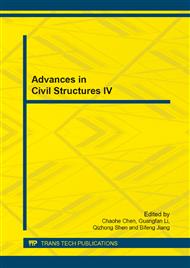[1]
Song H. -W., Saraswathy V. Corrosion monitoring of reinforced concrete structures - A review / International Journal of Electrochemical Science. 2007. №2. P. 1-28.
Google Scholar
[2]
Ahmad S. Reinforcement corrosion in concrete structures, its monitoring and service life prediction - A review / Cement and Concrete Composites. 2003. №25. P. 459-471.
DOI: 10.1016/s0958-9465(02)00086-0
Google Scholar
[3]
EBM 218. 3. 001-2010 Guidelines for diagnosing active corrosion of reinforcement in concrete structures of bridges on the roads by the half-cell potential method.
Google Scholar
[4]
I.К. Matveev Active reinforcement corrosion diagnostic in concrete constructions of bridges / I.К. Matveev, V.K. Matveev, K.M. Shevchuk, R.М. Drygin / The World of Roads. 2010. № 49. -P. 54-58.
Google Scholar
[5]
Bazhenov Yu.M. Concrete technology. - M: Publishing house of the ASV, 2002. - 500p.
Google Scholar
[6]
Liu R. Influence of carbonation on chloride-induced reinforcement corrosion in simulated concrete pore solutions / Liu R., Jiang L., Xu J., Xiong C., Song Z. / Construction and Building Materials. 2014. № 56. P. 16-20.
DOI: 10.1016/j.conbuildmat.2014.01.030
Google Scholar
[6]
Vetrov S.N. The specifics of the survey of the state of reinforced concrete structures in the conditions of aggressive water influence / S.N. Vetrov, S.V. Yakovlev / magazine of Building and Engineering. - 2010. - №7(17). - P. 35-40.
Google Scholar
[7]
Angst U. Critical chloride content in reinforced concrete - A review / Angst U. , Elsener B., Larsen C.K., Vennesland Ø /Cement and Concrete Research. 2009. №39. P. 1122-1138.
DOI: 10.1016/j.cemconres.2009.08.006
Google Scholar
[8]
Montemor M.F. , Simões A.M.P., Ferreira M.G.S. Chloride-induced corrosion on reinforcing steel: From the fundamentals to the monitoring techniques / Cement and Concrete Composites. 2003, №25. P. 491-502.
DOI: 10.1016/s0958-9465(02)00089-6
Google Scholar
[9]
ASTM C876 Standards Test Method for Half-cell Potentials of Reinforcing Steel in Concrete.
Google Scholar
[10]
Archie G.E. The electrical resistivity log as an aid in determining some reservoir characteristics AIME Trans. 1942. №146.
DOI: 10.2118/942054-g
Google Scholar
[11]
Rob B. Polder. Test methods for on site measurement of resistivity of concrete - a RILEM TC-154 technical recommendation/ Construction and Building Materials. 2001. №15. - P. 125-131.
DOI: 10.1016/s0950-0618(00)00061-1
Google Scholar
[12]
Gowers KR, Millard SG. Measurement of concrete resistivity for assessment of corrosion severity of steel using Wenner technique. ACI J Mater September October, 1999 P. 536-541.
DOI: 10.14359/655
Google Scholar
[13]
Broomfield J.P. Cathodic Protection for Reinforced Concrete: Its Application to Buildings and Marine Structures / J.P. Broomfield, P.E. Langford, R. McAnoy / CORROSION/87 Houston, TX: NACE International, (1987).
DOI: 10.1016/b978-1-4832-8386-9.50090-5
Google Scholar


